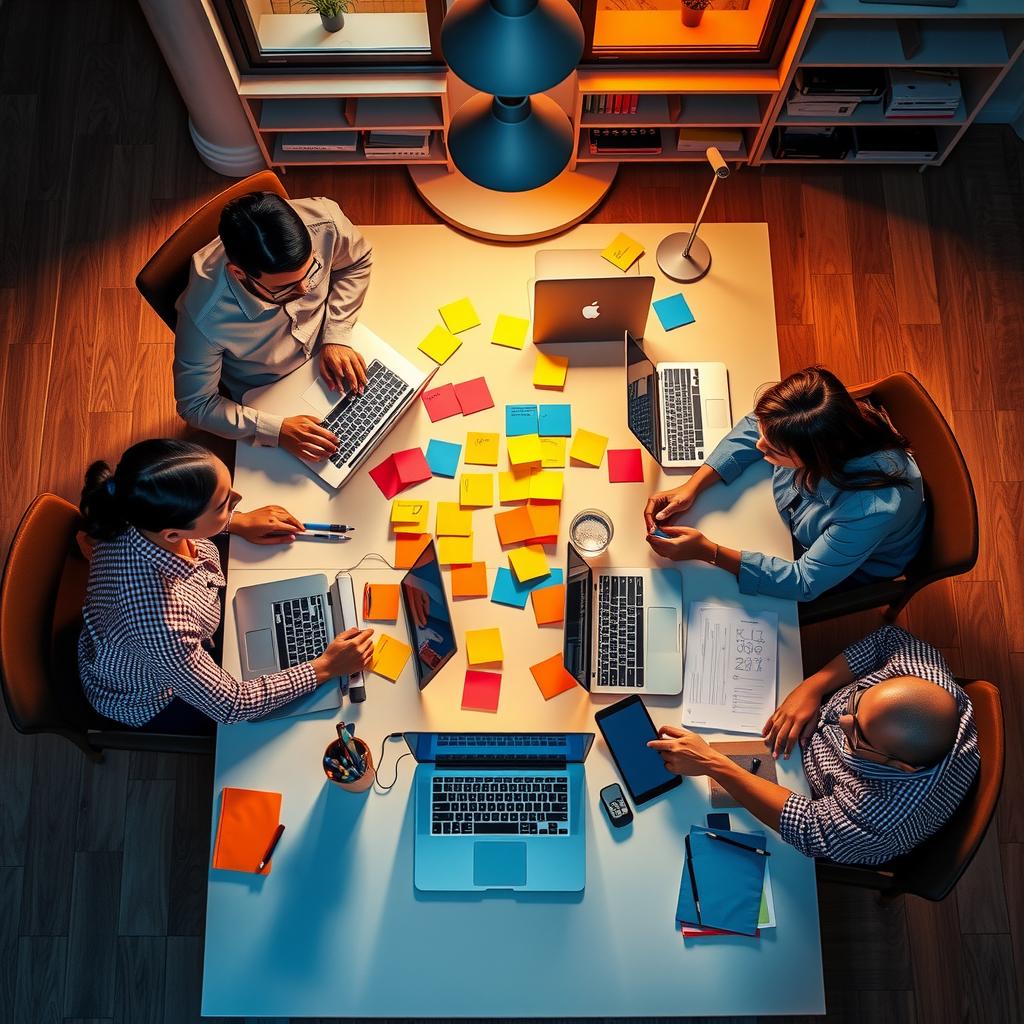In an era where teams are increasingly distributed across different locations, the challenge of maintaining effective communication and collaboration has become more pronounced than ever. Remote work presents unique hurdles, especially when it comes to note taking during meetings or brainstorming sessions. Miscommunication can lead to misunderstandings and a decline in productivity, which is why organizations must seek out innovative solutions that enhance remote collaboration. This blog post addresses these concerns by exploring some of the best methods for efficient note taking tailored specifically for virtual teamwork.
The importance of clear and organized information sharing cannot be overstated in today’s fast-paced digital landscape. With various tools at their disposal, teams need to adopt strategies that not only facilitate seamless team communication but also ensure that critical insights are captured accurately and shared effectively among all members. By incorporating effective methods into their workflow, remote teams can significantly improve their overall productivity while creating an inclusive environment where everyone’s contributions are valued.
This article delves into several proven techniques designed to optimize how remote teams approach note taking, ensuring that essential details from discussions do not get lost in translation. From collaborative platforms that allow real-time editing to structured templates that guide participants through key points, there is no shortage of options available for those seeking improvement in this area. Moreover, implementing these practices can foster a sense of unity within diverse groups as they work together toward common objectives.
As readers explore the various strategies outlined here, they will uncover actionable tips aimed at enhancing both individual effectiveness and collective performance during virtual interactions. The goal is simple: equip readers with knowledge about practical tools and methodologies that elevate the quality of their notes while driving engagement throughout the team dynamic. Ultimately, embracing these approaches could transform how remote professionals share information—leading not just to better understanding but also stronger connections across distances.
Join us on this journey as we examine some top-tier recommendations for refining your team’s note-taking processes amidst the evolving landscape of remote work!

Key Insights:
-
Structured Note-Taking Techniques: Implementing a structured approach to note-taking can significantly enhance clarity in discussions. By organizing notes with headings, bullet points, and numbered lists, team members are more likely to capture essential details accurately. This method not only aids in retention but also facilitates easier reference during future meetings or project updates.
-
Utilization of Collaborative Tools: Leveraging collaborative tools designed for virtual teamwork is crucial for enhancing remote collaboration. Platforms like shared documents or project management software allow team members to edit and contribute in real-time. These tools promote information sharing, ensuring that everyone stays informed about decisions made and tasks assigned, thereby minimizing the chances of misunderstandings.
-
Adopting Readable Formatting Styles: The way notes are formatted can have a significant impact on their effectiveness. Adopting clear formatting styles—such as using distinct font sizes for headings or incorporating color codes for different topics—can improve readability. This practice not only helps maintain engagement during discussions but also fosters an environment where accountability thrives, as all members can easily follow along with the documented information.
By mastering these effective methods tailored for note taking, teams can navigate the challenges of remote work more successfully while maintaining high levels of productivity and cohesion across geographical barriers.

Introduction: Understanding the Importance of Note-Taking in Remote Collaboration
The Role of Effective Note-Taking in Enhancing Team Dynamics
In a world where remote collaboration has become the norm, effective note-taking emerges as a vital tool for promoting cohesive team dynamics. The absence of face-to-face interactions can often lead to misunderstandings and gaps in communication; however, structured notes serve as a bridge that connects ideas and clarifies intentions. By capturing essential points during discussions, teams can ensure that everyone is aligned on objectives and action items. Moreover, note-taking fosters accountability by providing a clear record of decisions made and tasks assigned. As individuals sift through their notes after meetings, they are better equipped to manage their responsibilities and track progress within projects.
Bridging Communication Gaps Through Structured Notes
Structured notes not only enhance individual productivity but also facilitate seamless information sharing among team members. In many cases, remote teams utilize various collaboration tools to communicate effectively; however, without proper documentation, critical insights may slip through the cracks. When notes are organized logically—incorporating bullet points or themed headings—they allow all participants easy access to relevant data at any time. This practice diminishes reliance on memory alone while simultaneously reducing repetitive inquiries about previously discussed topics. Furthermore, cultivating an environment where team communication thrives hinges upon transparency—a goal that effective note-taking actively supports.
Boosting Productivity with Collaborative Notetaking Techniques
To maximize productivity within virtual teamwork environments, organizations should consider implementing collaborative note-taking techniques such as shared documents or dedicated channels for real-time updates. These methods encourage immediate feedback from colleagues while ensuring that everyone contributes equally to capturing meaningful dialogue during meetings or brainstorming sessions. As each member adds their insights into the shared space—whether it be via comments or edits—the document evolves into a comprehensive resource reflecting diverse perspectives tailored towards solving problems collectively. Ultimately,productivity tips rooted in collaborative practices help foster engagement among remote workers who might otherwise feel isolated from one another.
Tools for Effective Information Sharing Among Remote Teams
The rise of numerous digital platforms offers ample opportunities for optimizing note-sharing processes across diverse teams engaged in distant workspaces today.Collaboration tools, such as online whiteboards or project management applications integrated with notetaking features provide practical solutions designed specifically for this purpose. Utilizing these resources allows groups not only to compile comprehensive meeting summaries but also enables them access past records whenever necessary—an invaluable asset when revisiting project milestones or troubleshooting challenges encountered along the way! Adopting technology-driven approaches ensures streamlined workflows irrespective of geographical locations while maintaining consistent alignment amongst all parties involved.
Cultivating an Organizational Culture Centered around Note-Taking Practices
Lastly, fostering an organizational culture centered around diligent note-taking practices enhances overall operational efficiency significantly over time! When leadership exemplifies commitment toward meticulous documentation habits during virtual meetings (i.e., assigning designated ‘note-takers’), they set precedence encouraging others throughout their ranks too adopt similar behaviors leading ultimately towards heightened collective performance standards observed consistently across different departments alike! To support this initiative further requires ongoing training workshops emphasizing skills development surrounding effective strategies related directly back again onto enhancing remote collaboration efforts moving forward!
By understanding these fundamental aspects regarding how integral accurate recording plays into supporting successful outcomes achieved collaboratively despite being physically apart—teams stand poised ready tackle any challenge thrown ahead confidently together!
Strategies for Effective Note-Taking
Enhancing Communication through Structured Documentation
In today’s fast-paced work environment, particularly in the realm of remote collaboration, effective note-taking plays a pivotal role in improving team communication. Implementing structured methods for documentation can significantly enhance clarity and ensure alignment among team members during virtual meetings. One such method is the Cornell Note-Taking System, which allows participants to divide their notes into concise sections that facilitate easy review and information sharing after meetings. This approach not only promotes active listening but also ensures that key points are captured systematically, thus enhancing productivity.
Another effective method involves using digital collaboration tools designed specifically for virtual teamwork. Platforms like shared documents or dedicated note-taking applications provide teams with a centralized space where members can contribute to notes in real time. This collaborative environment encourages participation from all team members, fostering a sense of ownership over the meeting outcomes. Furthermore, utilizing features such as tagging or commenting enables quick reference to important topics discussed during meetings, ensuring that everyone remains aligned on objectives and action items.
When it comes to enhancing note-taking effectiveness, employing visual techniques such as mind mapping can also be beneficial. Mind maps allow individuals to organize thoughts visually while connecting various ideas discussed during a meeting. By capturing concepts and their relationships through diagrams, teams often find it easier to recall discussions later on. This technique not only aids memory retention but also serves as an engaging way of presenting information that may otherwise become overwhelming when noted linearly.
Moreover, incorporating follow-up strategies post-meeting is crucial for maintaining momentum within the team’s projects. Distributing summarized notes along with actionable takeaways fosters accountability among team members regarding their assigned tasks while keeping everyone informed about collective progress made towards goals set during discussions. Additionally, scheduling brief check-ins after major meetings ensures any lingering questions are addressed promptly—thus reinforcing clear lines of communication.
To maximize effectiveness further in remote settings where distractions abound, adopting techniques such as timed sessions or designated quiet hours can help streamline focus during note-taking processes around virtual collaboration environments. Establishing these parameters creates an atmosphere conducive to concentrated efforts on documenting essential insights without interruptions—a vital aspect of achieving overall project success.
By implementing these varied strategies within the framework of effective note-taking practices tailored towards information sharing, teams can navigate challenges posed by remote work more adeptly than ever before—ultimately resulting in enhanced synergy across all levels of operation within organizations committed toward continuous improvement.
Fostering Accountability Through Effective Note-Taking
Enhancing Team Engagement and Collaboration
In today’s fast-paced work environment, fostering a culture of accountability is essential for the success of any team. One effective method to achieve this is through note-taking practices that enhance engagement and promote a sense of responsibility among team members. When individuals regularly document discussions, decisions, and action items during meetings—whether in person or via remote collaboration—it creates a shared repository of information that everyone can refer back to. This transparency not only helps clarify expectations but also encourages team communication by ensuring that all voices are heard and acknowledged. Furthermore, utilizing digital collaboration tools can significantly simplify the process; these platforms often come equipped with features designed specifically for information sharing, enabling seamless integration into daily routines.
Effective methods for note-taking go beyond merely recording what was said during meetings. They involve synthesizing key points and outlining actionable steps in a way that resonates with all participants. For instance, using bullet points or categorizing notes under specific themes makes it easier to digest information quickly while promoting accountability; when tasks are assigned clearly within documented notes, each member understands their responsibilities better. Consequently, this leads to improved productivity as individuals are more likely to follow through on commitments when they see them laid out explicitly.
Moreover, incorporating regular check-ins where teams review their collective notes fosters an environment conducive to feedback and discussion about progress made on various tasks. Such practices not only bolster individual productivity tips but also enhance overall team dynamics by reinforcing collaborative efforts toward common goals. The act of revisiting past discussions ensures continuity in projects while allowing teams to adjust strategies based on previous outcomes—a crucial aspect of effective virtual teamwork.
Ultimately, integrating strategic note-taking into everyday workflows nurtures an ethos centered around accountability within teams. As members grow accustomed to documenting insights meticulously and reflecting upon them collectively, they cultivate trust amongst one another while advancing their professional development together. By embracing these principles rooted in organization and clarity through dedicated note management systems or applications tailored for remote interactions—teams unlock new potentials for synergy that propel initiatives forward with momentum previously unimagined.
Through engaging techniques such as structured reflection on recorded material and active participation during meetings facilitated by easy-to-use resources designed specifically for collaboration purposes—the journey towards heightened accountability becomes increasingly attainable in any organizational context.
FAQ:
Q: What are some effective note-taking techniques for remote teams?
A: Implementing structured note-taking practices is essential for enhancing clarity during remote collaboration. Teams should consider using collaborative tools that allow real-time editing and sharing of notes, ensuring all members can contribute to and access vital information. Adoption of specific formatting styles, such as bullet points or numbered lists, can boost readability, making it easier for team members to grasp key details quickly.
Q: How can note-taking improve communication in virtual meetings?
A: Effective methods of documenting discussions play a significant role in promoting information sharing among team members. When notes are organized clearly and shared promptly after meetings, they serve as a reference point that helps avoid misunderstandings and miscommunication. Additionally, encouraging team members to engage with the notes through comments or questions fosters an environment of active participation.
Q: What tools should teams use for better note-taking in remote work settings?
A: Choosing the right collaboration tools is crucial for optimizing team communication during remote work. Tools designed specifically for virtual teamwork, such as cloud-based document editors or project management platforms with integrated note features, facilitate seamless access to shared information. These tools not only enhance productivity but also ensure that valuable insights captured during discussions do not slip through the cracks.
